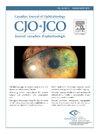异体造血干细胞移植患者慢性移植物抗宿主疾病的眼部筛查
IF 3.3
4区 医学
Q1 OPHTHALMOLOGY
Canadian journal of ophthalmology. Journal canadien d'ophtalmologie
Pub Date : 2025-02-01
DOI:10.1016/j.jcjo.2024.04.005
引用次数: 0
摘要
目的研究德克萨斯大学医学分部(UTMB)同种异体造血干细胞移植(HSCT)患者移植物抗宿主病的眼部表现。首选实践模式指南提出了眼移植物抗宿主病(oGHVD)检测。方法采用《国际疾病分类第十版》(ICD-10)、骨髓移植、干细胞移植编码、骨髓移植和干细胞移植并发症编码对南京中医药大学Epic电子病历数据库进行筛选。我们确定了2000年至2021年间在UTMB看到的50例具有ICD-10代码的患者。接受HSCT和UTMB随访治疗的患者被纳入本研究。38例患者符合纳入标准,而12例患者因未诊断出HSCT或未进行UTMB随访而被排除。在我们的队列中的38例患者中,23.7% (n = 9)被注意到患有oGVHD。多达89%的oGVHD患者表现为眼表疾病,包括角膜结膜炎、睑板腺功能障碍和干眼综合征。44%的oGVHD患者还发现了全身性GVHD。只有29% (n = 11)的研究人群转诊至眼科。大多数转介(55%)是在接受HSCT后1年内进行的。在我们的队列中,没有患者在移植前接受过眼部筛查。结论许多hsct术后患者缺乏常规眼科护理。定期评估hsct后患者oGVHD的早期体征和症状可能会限制不良后果。oGVHD的管理应涉及多学科团队的方法。目的:研究美国德州大学(UTMB,德克萨斯大学医学分院)教师的本文章由计算机程序翻译,如有差异,请以英文原文为准。
Ocular screening for chronic graft-versus-host disease in patients with allogeneic hematopoietic stem cell transplant
Objective
This study investigates ocular manifestations of graft-versus-host disease in patients following allogeneic hematopoietic stem cell transplantation (HSCT) at the University of Texas Medical Branch (UTMB). Preferred practice pattern guidelines are proposed for ocular graft-versus-host disease (oGHVD) detection.
Methods
The Epic electronic medical record database at UTMB was screened using International Classification of Diseases, Tenth Revision (ICD-10), codes for bone marrow transplants, stem cell transplants, and complications of bone marrow transplants and stem cell transplants. We identified 50 patients with the ICD-10 codes that were seen at UTMB between 2000 and 2021. Patients who received an HSCT and follow-up care with UTMB were included in this study. Thirty-eight patients met the inclusion criteria, whereas 12 patients were excluded because they had no diagnosis of HSCT or did not follow-up with UTMB.
Results
Of the 38 patients in our cohort, 23.7% (n = 9) were noted to have oGVHD. As many as 89% of the patients with oGVHD presented with an ocular surface disease including keratoconjunctivitis sicca, meibomian gland dysfunction, and dry eye syndrome. Systemic GVHD also was found in 44% of the patients with oGVHD. Only 29% (n = 11) of the study population had referrals to ophthalmology. Most referrals (55%) were made within 1 year of getting the HSCT. None of the patients in our cohort received an ocular screening before HSCT.
Conclusions
Many post-HSCT patients lack routine ophthalmic care. Regularly assessing post-HSCT patients for early signs and symptoms of oGVHD may limit adverse outcomes. Management of oGVHD should involve a multidisciplinary team approach.
Objectif
La présente étude se penche sur les manifestations oculaires de la maladie du greffon contre l'hôte (MGCH) chez des patients qui ont reçu une allogreffe de cellules souches hématopoïétiques (ACSH) à la faculté de médecine de l'Université du Texas (UTMB, pour University of Texas Medical Branch). On y propose des lignes directrices en matière de pratiques courantes privilégiées (Preferred Practice Pattern® Guidelines de l'AAO) en vue du dépistage de la MGCH oculaire.
Méthodes
On a extrait les codes correspondant aux greffes de moelle osseuse et aux greffes de cellules souches de même qu’à leurs complications selon la classification internationale des maladies (CIM-10) dans la base de données des dossiers médicaux électroniques Epic de l'UTMB. On a ainsi recensé 50 patients auxquels on a attribué ces codes à l'UTMB entre 2000 et 2021. Seuls les patients qui ont reçu une ACSH à l'UTMB et qui y ont été suivis ont été inclus dans notre étude : 38 patients répondaient aux critères d'inclusion, et 12 patients ont été exclus parce qu'ils n'avaient jamais reçu de diagnostic de MGCH ou n'avaient pas été suivis à l'UTMB.
Résultats
Sur les 38 patients de notre cohorte, 23,7 % (n = 9) présentaient une MGCH oculaire. On a observé une pathologie de la surface oculaire – notamment la kératoconjonctivite sèche, le dysfonctionnement des glandes de Meibomius et la sécheresse oculaire – dans une proportion pouvant atteindre 89 % des patients atteints de MGCH oculaire. On a en outre noté des manifestations générales de la MGCH chez 44 % des patients qui présentaient une MGCH oculaire. Seuls 29 % (n = 11) des patients de l’étude avaient été adressés à un ophtalmologiste. La plupart de ces derniers patients (55 %) avaient été orientés vers le service d'ophtalmologie au cours des 12 mois suivant l'ACSH. Aucun des patients de notre cohorte n'a fait l'objet d'un dépistage oculaire avant l'ACSH.
Conclusions
Bon nombre de patients qui ont reçu une ACSH ne bénéficient pas de soins ophtalmologiques systématiques. L'examen régulier des patients qui ont fait l'objet d'une ACSH afin de mettre au jour les signes et symptômes précoces d'une MGCH oculaire pourrait en atténuer les conséquences néfastes. La prise en charge de la MGCH oculaire doit faire appel à une équipe multidisciplinaire.
求助全文
通过发布文献求助,成功后即可免费获取论文全文。
去求助
来源期刊
CiteScore
3.20
自引率
4.80%
发文量
223
审稿时长
38 days
期刊介绍:
Official journal of the Canadian Ophthalmological Society.
The Canadian Journal of Ophthalmology (CJO) is the official journal of the Canadian Ophthalmological Society and is committed to timely publication of original, peer-reviewed ophthalmology and vision science articles.

 求助内容:
求助内容: 应助结果提醒方式:
应助结果提醒方式:


